Optimisation of the Flame Spheroidisation Process for the Rapid Manufacture of Fe3O4-Based Porous and Dense Microspheres
Abstract
1. Introduction
2. Results
2.1. Effect of Fe3O4:CaCO3 Mass Ratio
2.1.1. Size Range of Microsphere Reaction Products (Unsieved)
2.1.2. Structural Characterisation (Unsieved Microspheres)
2.1.3. Microsphere Magnetic Properties (Sieved)
2.1.4. Fine Scale Morphologies and Compositional Analyses (Sieved and Sectioned)
2.2. Effect of O2/C2H2 Gas Flow Setting
2.2.1. Size Range of Microsphere Reaction Products (Unsieved)
2.2.2. Fine Scale Morphologies and Compositional Analyses (Sieved and Sectioned)
2.3. Ca2Fe2O5 Magnetic Microspheres (Mass Ratio 1:1; Gas Flow Setting 2:2)
2.3.1. Magnetic Properties of Ca2Fe2O5 Microspheres
2.3.2. Induction Heating Studies
3. Discussion
4. Materials and Methods
4.1. Materials
4.2. Flame Spheroidisation Parameters
4.3. Microsphere Characterisation
4.3.1. Microsphere Morphology and Size
4.3.2. X-ray Diffractometry
4.3.3. Magnetic Characterisation
4.3.4. Compositional Characterisation
4.3.5. High Frequency Induction Heating
5. Conclusions
Supplementary Materials
Author Contributions
Funding
Institutional Review Board Statement
Informed Consent Statement
Data Availability Statement
Acknowledgments
Conflicts of Interest
References
- McNamara, K.; Tofail, S.A.M. Nanoparticles in biomedical applications. Adv. Phys. X 2017, 2, 54–88. [Google Scholar] [CrossRef]
- Ong, B.H.; Devaraj, N.K.; Matsumoto, M.; Abdullah, M.H. Thermal stability of magnetite (Fe3O4) nanoparticles. MRS Proc. 2011, 1118, K03–K09. [Google Scholar] [CrossRef]
- Kumar, C.S.S.R.; Mohammad, F. Magnetic nanomaterials for hyperthermia-based therapy and controlled drug delivery. Adv. Drug Deliv. Rev. 2011, 63, 789–808. [Google Scholar] [CrossRef] [PubMed]
- Bae, S.; Lee, S.W.; Takemura, Y. Applications of NiFe2O4 nanoparticles for a hyperthermia agent in biomedicine. Appl. Phys. Lett. 2006, 89, 252503. [Google Scholar] [CrossRef]
- Kalaiselvan, C.R.; Thorat, N.D.; Sahu, N.K. Carboxylated PEG-Functionalized MnFe2O4 Nanocubes Synthesized in a Mixed Solvent: Morphology, Magnetic Properties, and Biomedical Applications. ACS Omega 2021, 6, 5266–5275. [Google Scholar] [CrossRef] [PubMed]
- Karthickraja, D.; Karthi, S.; Kumar, G.A.; Sardar, D.K.; Dannangoda, G.C.; Martirosyan, K.S.; Girija, E.K. Fabrication of core–shell CoFe2O4@HAp nanoparticles: A novel magnetic platform for biomedical applications. New J. Chem. 2019, 43, 13584–13593. [Google Scholar] [CrossRef]
- Srivastava, M.; Alla, S.K.; Meena, S.S.; Gupta, N.; Mandal, R.K.; Prasad, N.K. Magnetic field regulated, controlled hyperthermia with LixFe3-xO4 (0.06 ≤ x ≤ 0.3) nanoparticles. Ceram. Int. 2019, 45, 12028–12034. [Google Scholar] [CrossRef]
- Pereira, D.S.M.; Cardoso, B.D.; Rodrigues, A.R.O.; Amorim, C.O.; Amaral, V.S.; Almeida, B.G.; Queiroz, M.-J.R.P.; Martinho, O.; Baltazar, F.; Calhelha, R.C.; et al. Magnetoliposomes Containing Calcium Ferrite Nanoparticles for Applications in Breast Cancer Therapy. Pharmaceutics 2019, 11, 477. [Google Scholar] [CrossRef]
- Cardoso, B.D.; Rodrigues, A.R.O.; Almeida, B.G.; Amorim, C.O.; Amaral, V.S.; Castanheira, E.M.S.; Coutinho, P.J.G. Stealth Magnetoliposomes Based on Calcium-Substituted Magnesium Ferrite Nanoparticles for Curcumin Transport and Release. Int. J. Mol. Sci. 2020, 21, 3641. [Google Scholar] [CrossRef]
- Khanna, L.; Verma, N.K. Synthesis, characterization and in vitro cytotoxicity study of calcium ferrite nanoparticles. Mater. Sci. Semicond. Process. 2013, 16, 1842–1848. [Google Scholar] [CrossRef]
- Kheradmand, A.; Vahidi, O.; Masoudpanah, S.M. Magnetic, hyperthermic and structural properties of zn substituted CaFe2O4 powders. Appl. Phys. A 2018, 124, 255. [Google Scholar] [CrossRef]
- Bilas, R.; Sriram, K.; Maheswari, P.U.; Sheriffa Begum, K.M.M. Highly biocompatible chitosan with super paramagnetic calcium ferrite (CaFe2O4) nanoparticle for the release of ampicillin. Int. J. Biol. Macromol. 2017, 97, 513–525. [Google Scholar] [CrossRef] [PubMed]
- Naderi, E.; Aghajanzadeh, M.; Zamani, M.; Sharafi, A.; Naseri, M.; Danafar, H. The Effect of Calcination Temperature on the Anticancer Activity of CaFe2O4@PVA Nanocarriers: Photodynamic Therapy and Drug Delivery Study. J. Inorg. Organomet. Polym. Mater. 2020, 30, 5261–5269. [Google Scholar] [CrossRef]
- Khanna, L.; Verma, N.K. Biocompatibility and superparamagnetism in novel silica/CaFe2O4 nanocomposite. Mater. Lett. 2014, 128, 376–379. [Google Scholar] [CrossRef]
- Reyes-Rodríguez, P.Y.; Cortés-Hernández, D.A.; Ávila-Orta, C.A.; Sánchez, J.; Andrade-Guel, M.; Herrera-Guerrero, A.; Cabello-Alvarado, C.; Ramos-Martínez, V.H. Synthesis of Pluronic F127-coated magnesium/calcium (Mg1-xCaxFe2O4) magnetic nanoparticles for biomedical applications. J. Magn. Magn. Mater. 2021, 521, 167518. [Google Scholar] [CrossRef]
- Ruthradevi, T.; Akbar, J.; Suresh Kumar, G.; Thamizhavel, A.; Kumar, G.A.; Vatsa, R.K.; Dannangoda, G.C.; Martirosyan, K.S.; Girija, E.K. Investigations on nickel ferrite embedded calcium phosphate nanoparticles for biomedical applications. J. Alloys Compd. 2017, 695, 3211–3219. [Google Scholar] [CrossRef]
- Jasso-Terán, R.A.; Cortés-Hernández, D.A.; Sánchez-Fuentes, H.J.; Reyes-Rodríguez, P.Y.; de-León-Prado, L.E.; Escobedo-Bocardo, J.C.; Almanza-Robles, J.M. Synthesis, characterization and hemolysis studies of Zn(1−x)CaxFe2O4 ferrites synthesized by sol-gel for hyperthermia treatment applications. J. Magn. Magn. Mater. 2017, 427, 241–244. [Google Scholar] [CrossRef]
- Saldívar-Ramírez, M.M.; Sánchez-Torres, C.G.; Cortés-Hernández, D.A.; Escobedo-Bocardo, J.C.; Almanza-Robles, J.M.; Larson, A.; Reséndiz-Hernández, P.J.; Acuña-Gutiérrez, I.O. Study on the efficiency of nanosized magnetite and mixed ferrites in magnetic hyperthermia. J. Mater. Sci Mater. Med. 2014, 25, 2229–2236. [Google Scholar] [CrossRef]
- Hossain, K.M.Z.; Patel, U.; Ahmed, I. Development of microspheres for biomedical applications: A review. Prog. Biomater. 2015, 4, 1–19. [Google Scholar] [CrossRef]
- Cai, Y.; Chen, Y.; Hong, X.; Liu, Z.; Yuan, W. Porous microsphere and its applications. Int. J. Nanomed. 2013, 8, 1111–1120. [Google Scholar]
- Freiberg, S.; Zhu, X.X. Polymer microspheres for controlled drug release. Int. J. Pharm. 2004, 282, 1–18. [Google Scholar] [CrossRef] [PubMed]
- Sousa, A.L.; Ahmed, I. Manufacturing processes for polymeric micro and nanoparticles and their biomedical applications. AIMS Bioeng. 2017, 4, 46–72. [Google Scholar]
- Matamoros-Veloza, A.; Hossain, K.M.Z.; Scammell, B.E.; Ahmed, I.; Hall, R.; Kapur, N. Formulating injectable pastes of porous calcium phosphate glass microspheres for bone regeneration applications. J. Mech. Behav. Biomed. Mater. 2020, 102, 103489. [Google Scholar] [CrossRef] [PubMed]
- Gupta, D.; Hossain, K.M.Z.; Roe, M.; Smith, E.F.; Ahmed, I.; Sottile, V.; Grant, D.M. Long-Term Culture of Stem Cells on Phosphate-Based Glass Microspheres: Synergistic Role of Chemical Formulation and 3D Architecture. ACS Appl. Bio Mater. 2021, 4, 5987–6004. [Google Scholar] [CrossRef]
- Hossain, K.M.Z.; Patel, U.; Kennedy, A.R.; Macri-Pellizzeri, L.; Sottile, V.; Grant, D.M.; Scammell, B.E.; Ahmed, I. Porous calcium phosphate glass microspheres for orthobiologic applications. Acta Biomater. 2018, 72, 396–406. [Google Scholar] [CrossRef]
- Abou Neel, E.A.; Kiani, A.; Valappil, S.P.; Mordan, N.M.; Baek, S.-Y.; Zakir Hossain, K.M.; Felfel, R.M.; Ahmed, I.; Divakarl, K.; Chrzanowski, W.; et al. Glass microparticle- versus microsphere-filled experimental dental adhesives. J. Appl. Polym. Sci. 2019, 136, 47832. [Google Scholar] [CrossRef]
- Milborne, B.; Arafat, A.; Layfield, R.; Thompson, A.; Ahmed, I. The Use of Biomaterials in Internal Radiation Therapy. Recent Prog. Mater. 2020, 2, 1–34. [Google Scholar] [CrossRef]
- Chang, D.; Lim, M.; Goos, J.; Qiao, R.; Ng, Y.Y.; Mansfeld, F.M.; Jackson, M.; Davis, T.P.; Kavallaris, M. Biologically Targeted Magnetic Hyperthermia: Potential and Limitations. Front. Pharmacol. 2018, 9, 831. [Google Scholar] [CrossRef]
- Van der Zee, J. Heating the patient: A promising approach? Ann. Oncol. 2002, 13, 1173–1184. [Google Scholar] [CrossRef]
- Liu, X.; Zhang, Y.; Wang, Y.; Zhu, W.; Li, G.; Ma, X.; Zhang, Y.; Chen, S.; Tiwari, S.; Shi, K.; et al. Comprehensive understanding of magnetic hyperthermia for improving antitumor therapeutic efficacy. Theranostics 2020, 10, 3793–3815. [Google Scholar] [CrossRef]
- Grillone, A.; Ciofani, G. Magnetic Nanotransducers in Biomedicine. Chemistry 2017, 23, 16109–16114. [Google Scholar] [CrossRef] [PubMed]
- Kohane, D.S. Microparticles and nanoparticles for drug delivery. Biotechnol. Bioeng. 2007, 96, 203–209. [Google Scholar] [CrossRef] [PubMed]
- Arami, H.; Khandhar, A.; Liggitt, D.; Krishnan, K.M. In vivo delivery, pharmacokinetics, biodistribution and toxicity of iron oxide nanoparticles. Chem. Soc. Rev. 2015, 44, 8576–8607. [Google Scholar] [CrossRef] [PubMed]
- Velasco, M.V.; Souza, M.T.; Crovace, M.C.; Aparecido de Oliveira, A.J.; Zanotto, E.D. Bioactive magnetic glass-ceramics for cancer treatment. Biomed. Glasses 2019, 5, 148. [Google Scholar] [CrossRef]
- Rabin, Y. Is intracellular hyperthermia superior to extracellular hyperthermia in the thermal sense? Int. J. Hyperth. 2002, 18, 194–202. [Google Scholar] [CrossRef] [PubMed]
- Serantes, D.; Baldomir, D. Nanoparticle Size Threshold for Magnetic Agglomeration and Associated Hyperthermia Performance. Nanomaterials 2021, 11, 2786. [Google Scholar] [CrossRef]
- Engelmann, U.M.; Buhl, E.M.; Draack, S.; Viereck, T.; Ludwig, F.; Schmitz-Rode, T.; Slabu, I. Magnetic Relaxation of Agglomerated and Immobilized Iron Oxide Nanoparticles for Hyperthermia and Imaging Applications. IEEE Magn. Lett. 2018, 9, 1–5. [Google Scholar] [CrossRef]
- Mejías, R.; Hernández Flores, P.; Talelli, M.; Tajada-Herráiz, J.L.; Brollo, M.E.F.; Portilla, Y.; Morales, M.P.; Barber, D.F. Cell-Promoted Nanoparticle Aggregation Decreases Nanoparticle-Induced Hyperthermia under an Alternating Magnetic Field Independently of Nanoparticle Coating, Core Size, and Subcellular Localization. ACS Appl. Mater. Interfaces 2019, 11, 340–355. [Google Scholar] [CrossRef]
- Luderer, A.A.; Borrelli, N.F.; Panzarino, J.N.; Mansfield, G.R.; Hess, D.M.; Brown, J.L.; Barnett, E.H.; Hahn, E.W. Glass-ceramic-mediated, magnetic-field-induced localized hyperthermia: Response of a murine mammary carcinoma. Radiat. Res. 1983, 94, 190–198. [Google Scholar] [CrossRef]
- Łada, W.; Iller, E.; Wawszczak, D.; Konior, M.; Dziel, T. 90Y microspheres prepared by sol-gel method, promising medical material for radioembolization of liver malignancies. Mater. Sci. Eng. C 2016, 67, 629–635. [Google Scholar] [CrossRef]
- Berkmann, J.C.; Herrera Martin, A.X.; Pontremoli, C.; Zheng, K.; Bucher, C.H.; Ellinghaus, A.; Boccaccini, A.R.; Fiorilli, S.; Vitale Brovarone, C.; Duda, G.N.; et al. In Vivo Validation of Spray-Dried Mesoporous Bioactive Glass Microspheres Acting as Prolonged Local Release Systems for BMP-2 to Support Bone Regeneration. Pharmaceutics 2020, 12, 823. [Google Scholar] [CrossRef] [PubMed]
- Molinar Díaz, J.; Samad, S.A.; Steer, E.; Neate, N.; Constantin, H.; Islam, M.T.; Brown, P.D.; Ahmed, I. Flame spheroidisation of dense and porous Ca2Fe2O5 microspheres. Mater. Adv. 2020, 1, 3539–3544. [Google Scholar] [CrossRef]
- Gupta, D.; Hossain, K.M.Z.; Ahmed, I.; Sottile, V.; Grant, D.M. Flame-Spheroidized Phosphate-Based Glass Particles with Improved Characteristics for Applications in Mesenchymal Stem Cell Culture Therapy and Tissue Engineering. ACS Appl. Mater. Interfaces 2018, 10, 25972–25982. [Google Scholar] [CrossRef] [PubMed]
- Amorim, B.F.; Morales, M.A.; Bohn, F.; Carriço, A.S.; de Medeiros, S.N.; Dantas, A.L. Synthesis of stoichiometric Ca2Fe2O5 nanoparticles by high-energy ball milling and thermal annealing. Phys. B Condens. Matter 2016, 488, 43–48. [Google Scholar] [CrossRef]
- Asenath-Smith, E.; Lokuhewa, I.N.; Misture, S.T.; Edwards, D.D. p-Type thermoelectric properties of the oxygen-deficient perovskite Ca2Fe2O5 in the brownmillerite structure. J. Solid State Chem. 2010, 183, 1670–1677. [Google Scholar] [CrossRef]
- Serga, V.; Burve, R.; Maiorov, M.; Krumina, A.; Skaudžius, R.; Zarkow, A.; Kareiva, A.; Popov, A.I. Impact of Gadolinium on the Structure and Magnetic Properties of Nanocrystalline Powders of Iron Oxides Produced by the Extraction-Pyrolytic Method. Materials 2020, 13, 4147. [Google Scholar]
- Hanson, T.C.; Hackett, C.M.; Settles, G.S. Independent control of HVOF particle velocity and temperature. J. Therm. Spray Technol. 2002, 11, 75–85. [Google Scholar] [CrossRef]
- Kamnis, S.; Gu, S. Study of In-Flight and Impact Dynamics of Nonspherical Particles from HVOF Guns. J. Therm. Spray Technol. 2010, 19, 31–41. [Google Scholar] [CrossRef]
- Tikkanen, J.; Gross, K.A.; Berndt, C.C.; Pitkänen, V.; Keskinen, J.; Raghu, S.; Rajala, M.; Karthikeyan, J. Characteristics of the liquid flame spray process. Surf. Coat. Technol. 1997, 90, 210–216. [Google Scholar] [CrossRef]
- Shaterabadi, Z.; Nabiyouni, G.; Soleymani, M. Physics responsible for heating efficiency and self-controlled temperature rise of magnetic nanoparticles in magnetic hyperthermia therapy. Prog. Biophys. Mol. Biol. 2018, 133, 9–19. [Google Scholar] [CrossRef]
- Molinar-Díaz, J.; Woodliffe, J.L.; Milborne, B.; Murrell, L.; Islam, M.T.; Steer, E.; Weston, N.; Morley, N.A.; Brown, P.D.; Ahmed, I. Ferromagnetic Cytocompatible Glass-Ceramic Porous Microspheres for Magnetic Hyperthermia Applications. Adv. Mater. Interfaces 2023, 2202089. [Google Scholar] [CrossRef]
- Kouzoudis, D.; Samourgkanidis, G.; Kolokithas-Ntoukas, A.; Zoppellaro, G.; Spiliotopoulos, K. Magnetic Hyperthermia in the 400–1,100 kHz Frequency Range Using MIONs of Condensed Colloidal Nanocrystal Clusters. Front. Mater. 2021, 8, 638019. [Google Scholar] [CrossRef]
- Hergt, R.; Dutz, S. Magnetic Particle Hyperthermia—Biophysical Limitations of a Visionary Tumour Therapy. J. Magn. Magn. Mater. 2007, 311, 187–192. [Google Scholar] [CrossRef]
- Khan, A.S.; Nasir, M.F.; Khan, M.T.; Murtaza, A.; Hamayun, M.A. Study of structural, magnetic and radio frequency heating aptitudes of pure and (Fe-III) doped manganite (La1-x SrxMnO3) and their incorporation with Sodium Poly-Styrene Sulfonate (PSS) for magnetic hyperthermia applications. Phys. B Condens. Matter 2021, 600, 412627. [Google Scholar] [CrossRef]
- Park, J.-H.; Derfus, A.M.; Segal, E.; Vecchio, K.S.; Bhatia, S.N.; Sailor, M.J. Local Heating of Discrete Droplets Using Magnetic Porous Silicon-Based Photonic Crystals. J. Am. Chem. Soc. 2006, 128, 7938–7946. [Google Scholar] [CrossRef] [PubMed]
- Hidayat, T.; Shishin, D.; Decterov, S.; Jak, E. Thermodynamic Optimization of the Ca-Fe-O System. Metall. Mater. Trans. B 2015, 47, 256–281. [Google Scholar] [CrossRef]
- Torres-Lugo, M.; Rinaldi, C. Thermal potentiation of chemotherapy by magnetic nanoparticles. Nanomedicine 2013, 8, 1689–1707. [Google Scholar] [CrossRef]
- Issels, R.D. Hyperthermia adds to chemotherapy. Eur. J. Cancer 2008, 44, 2546–2554. [Google Scholar] [CrossRef]
- Pennacchioli, E.; Fiore, M.; Gronchi, A. Hyperthermia as an adjunctive treatment for soft-tissue sarcoma. Expert Rev. Anticancer. Ther. 2009, 9, 199–210. [Google Scholar] [CrossRef]

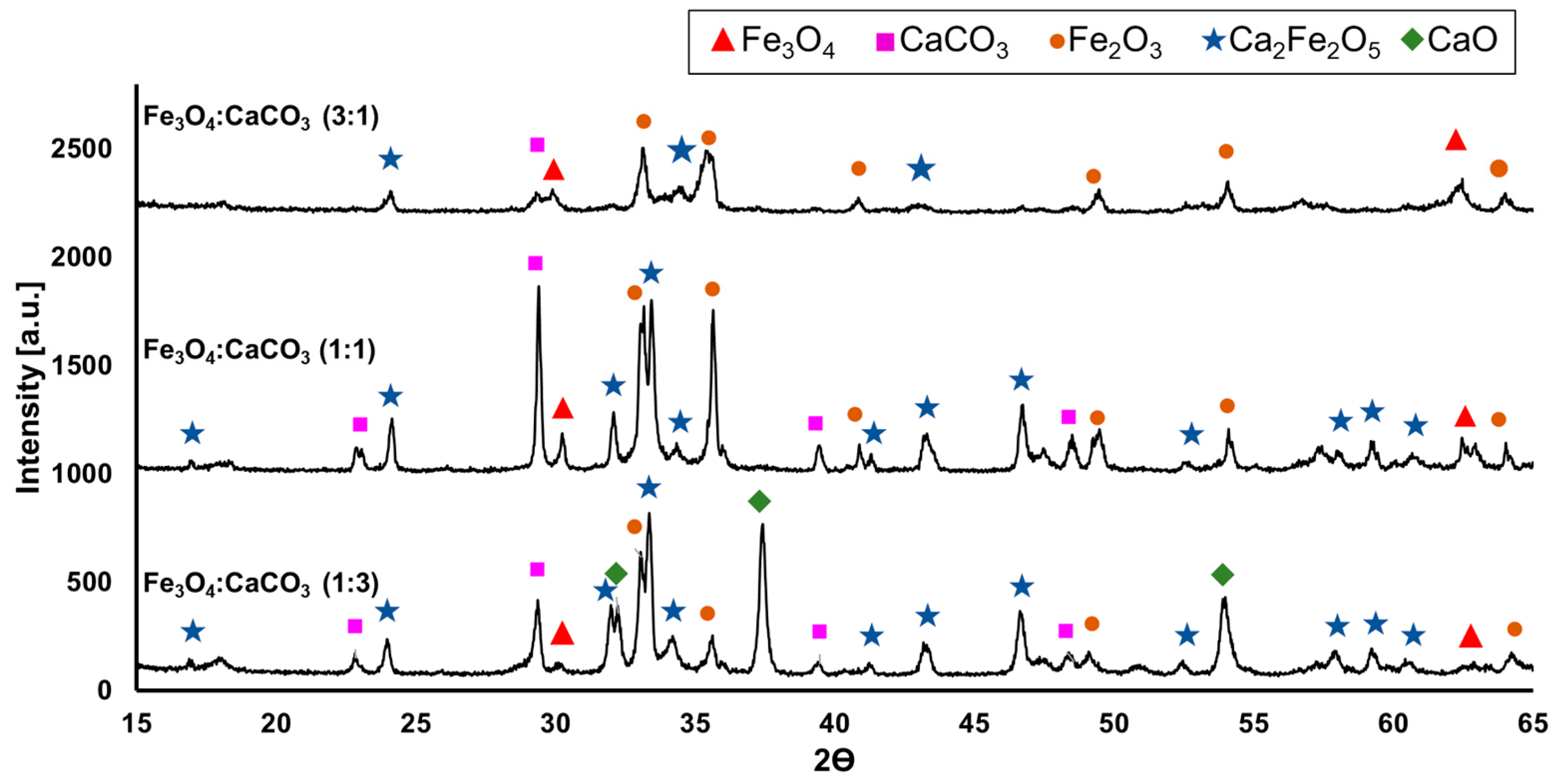
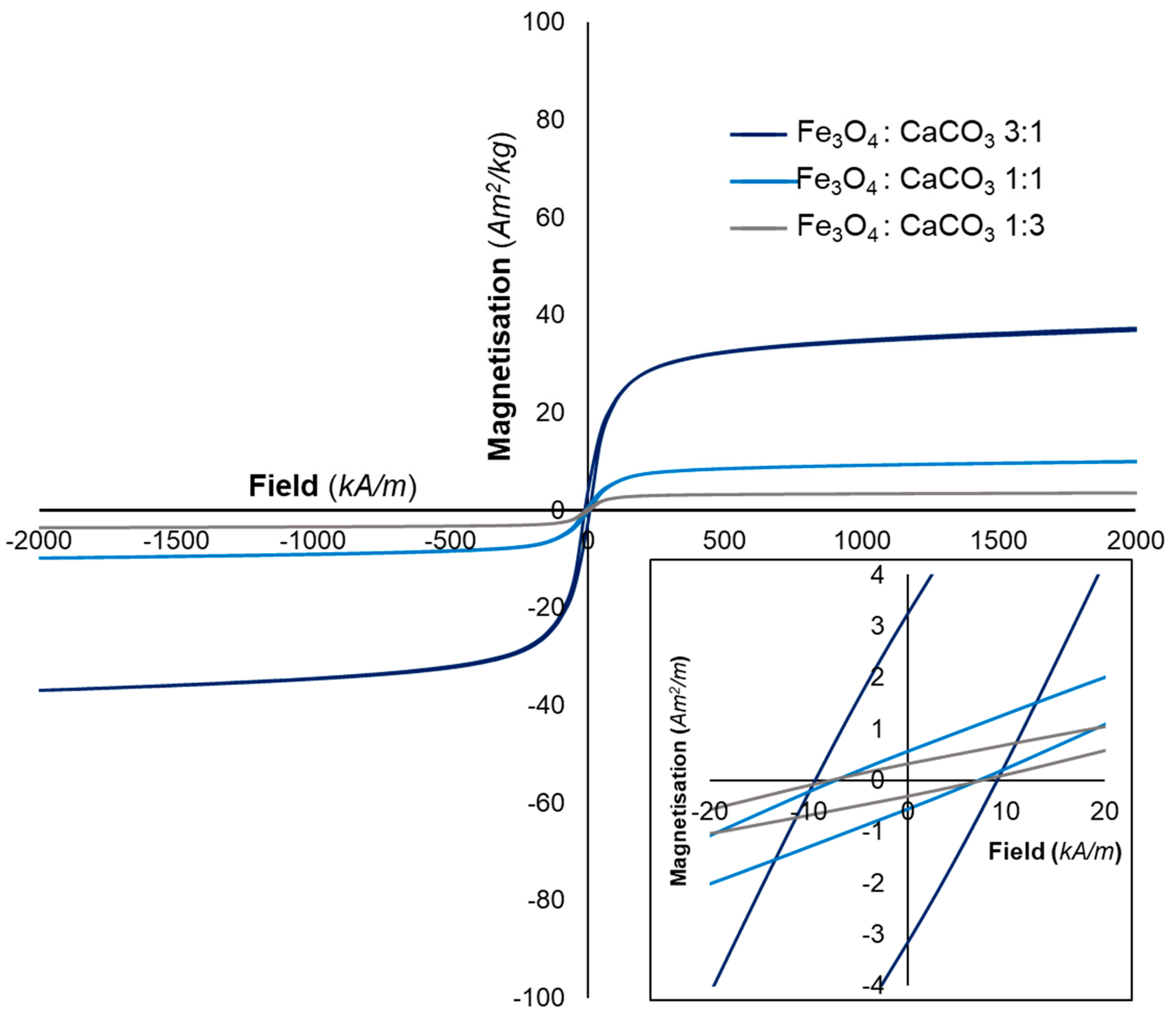

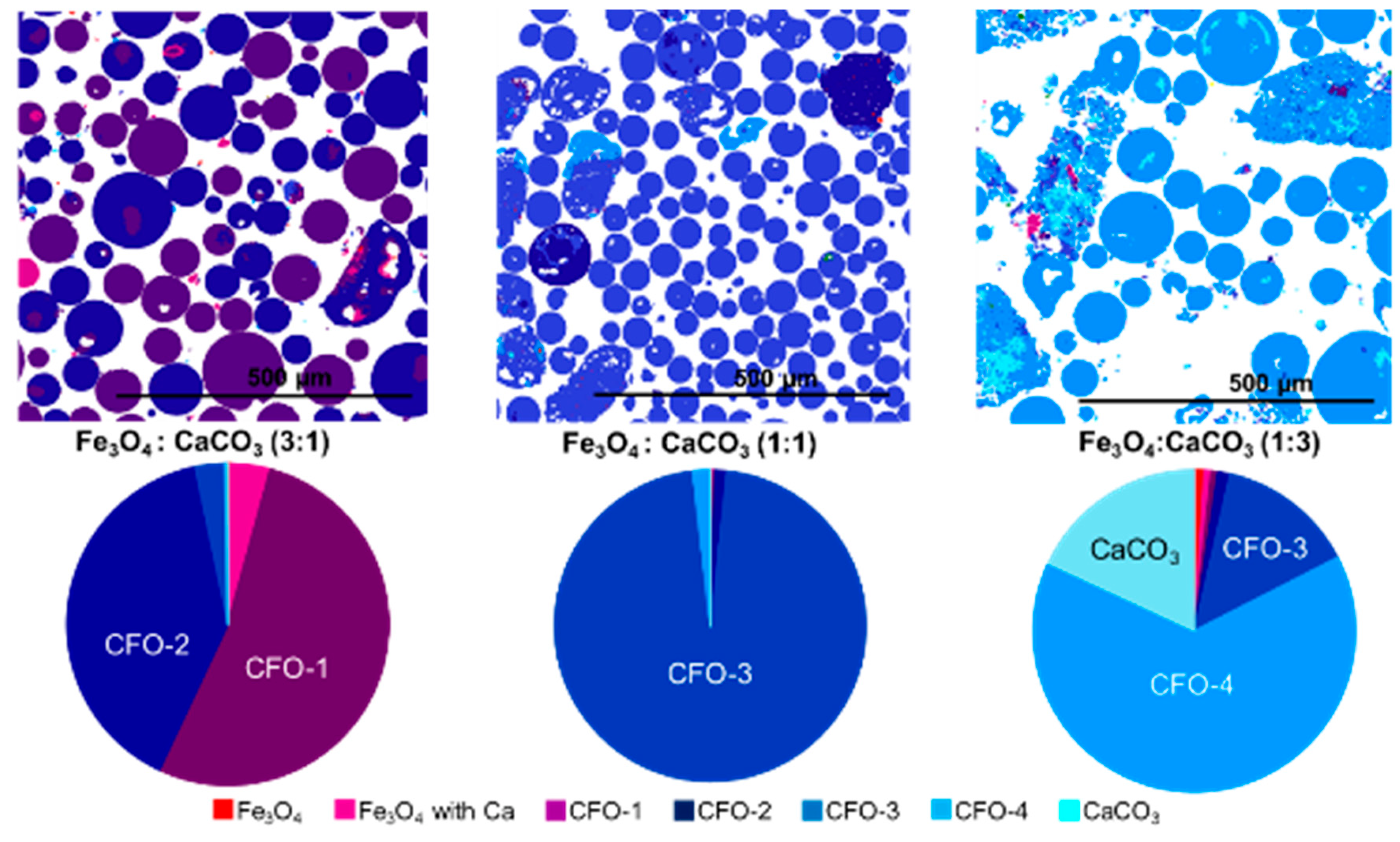
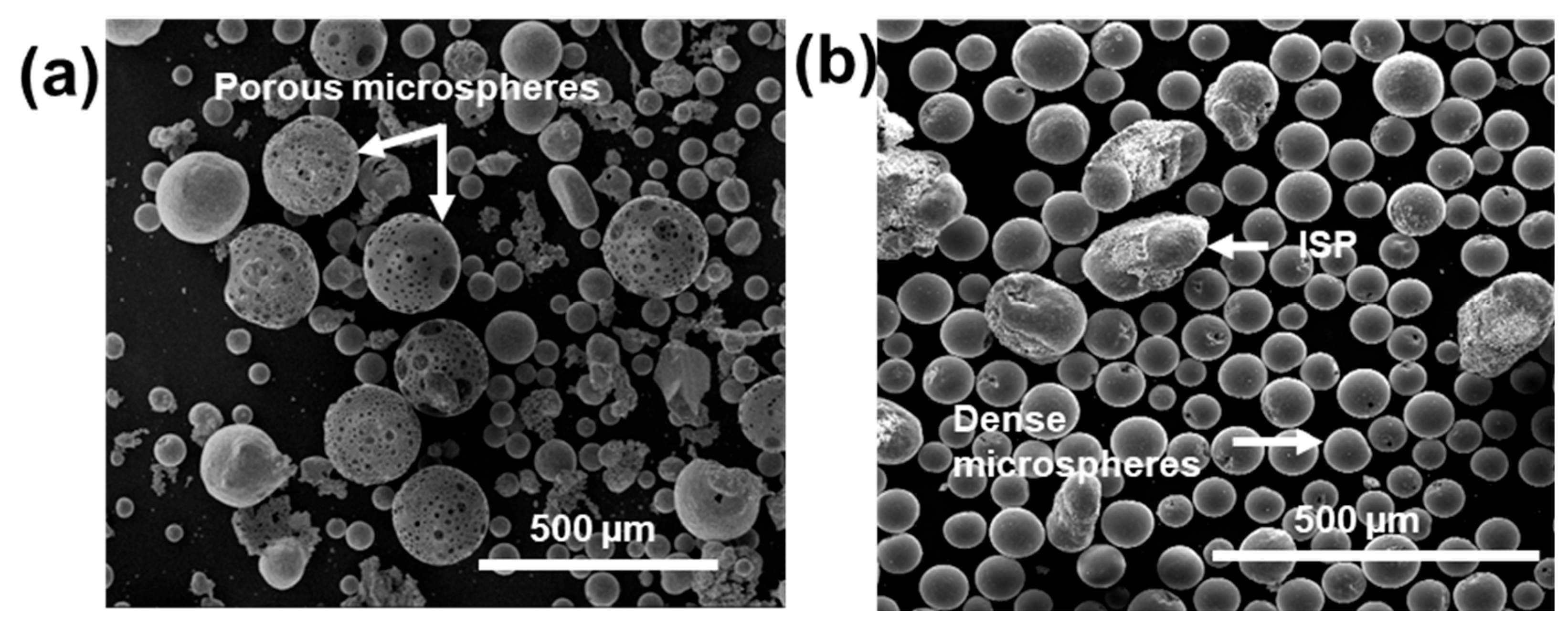
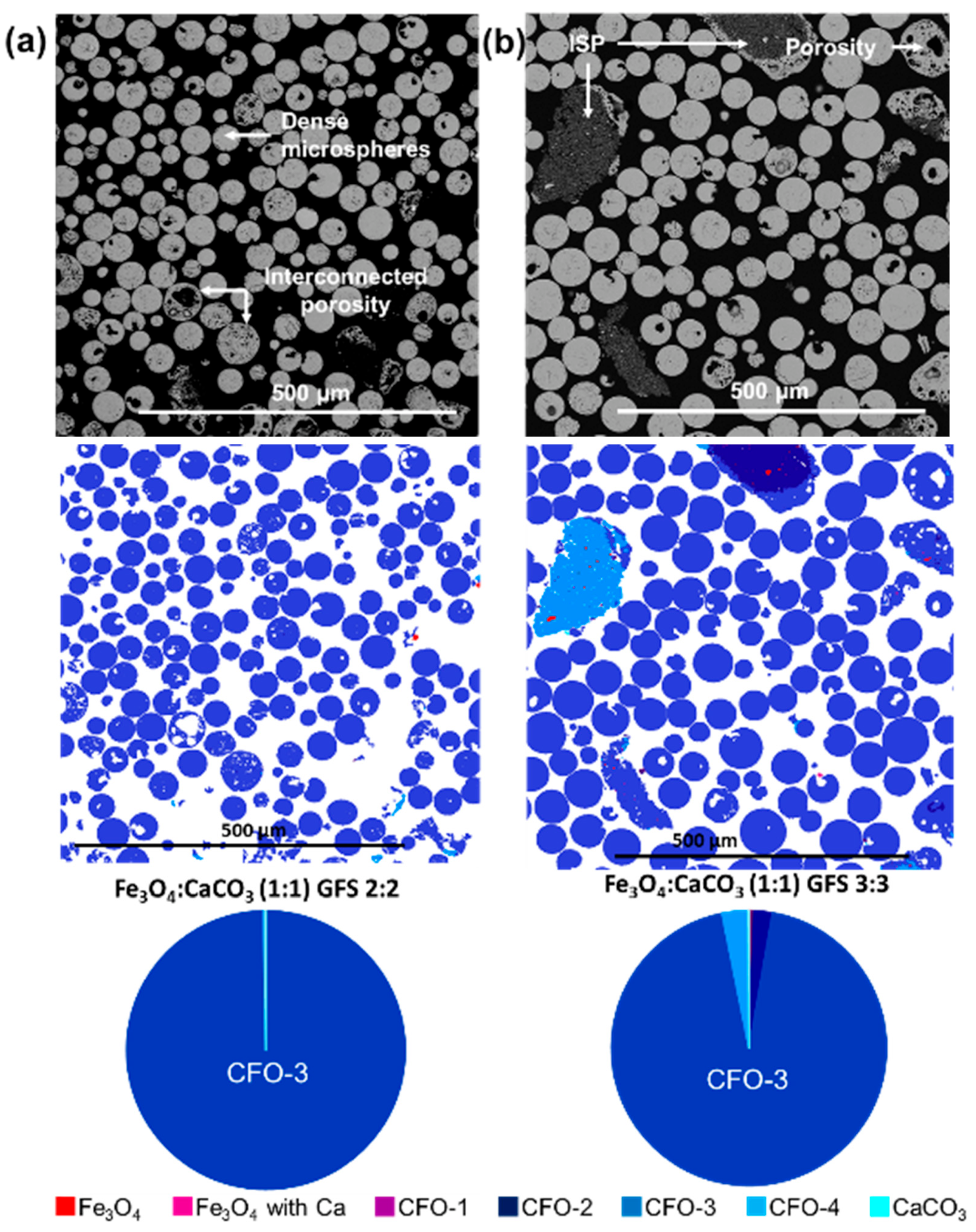
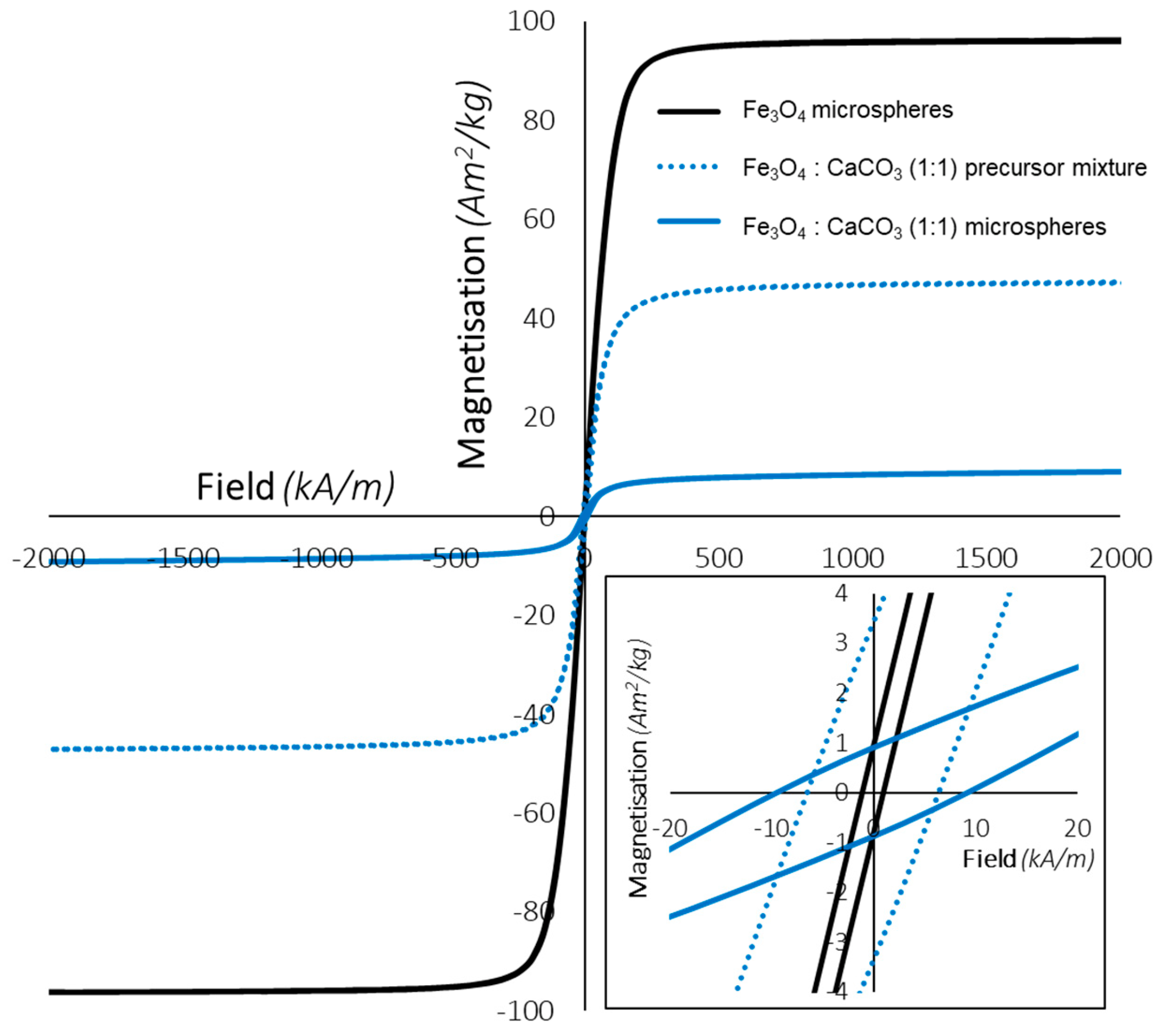
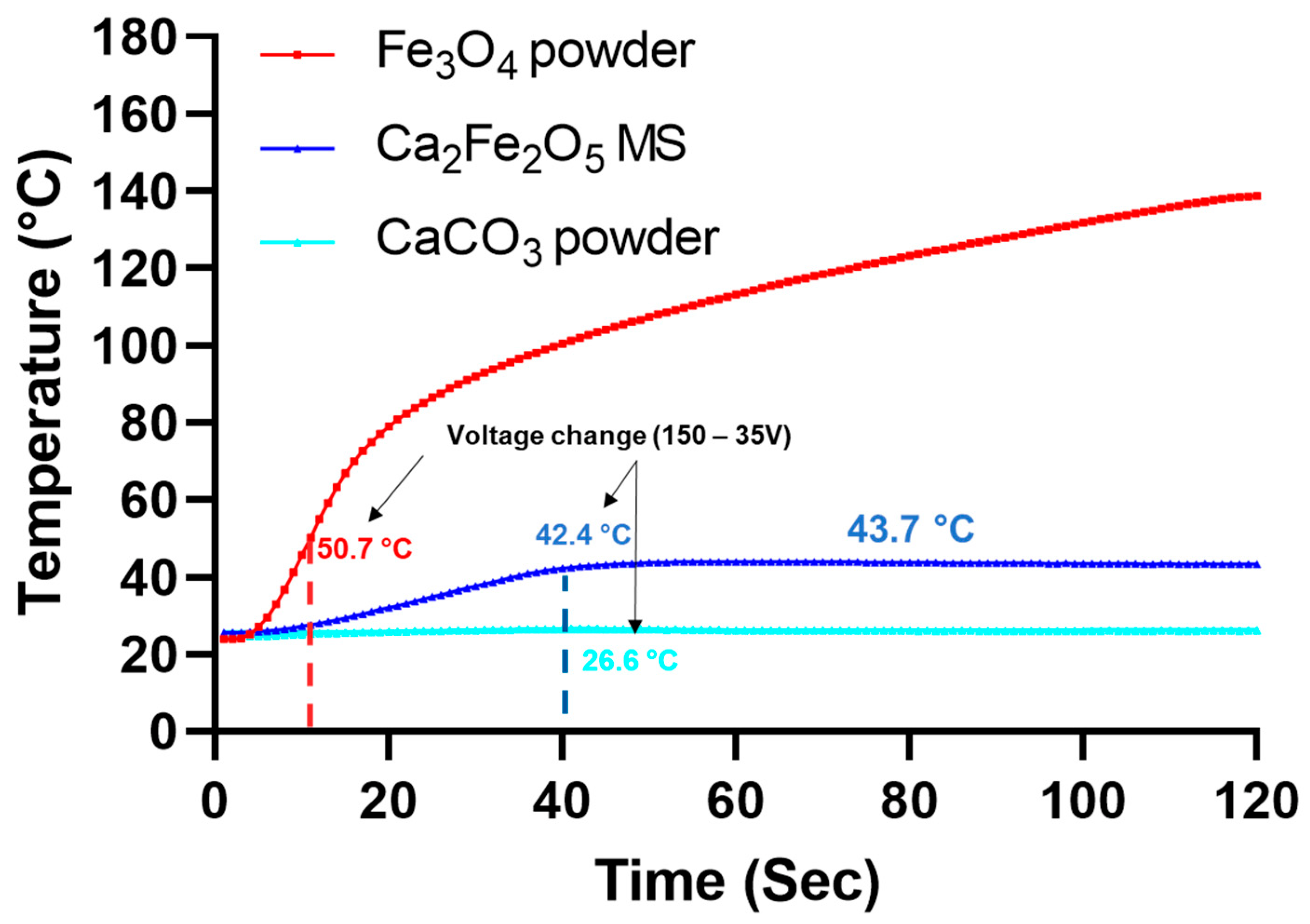
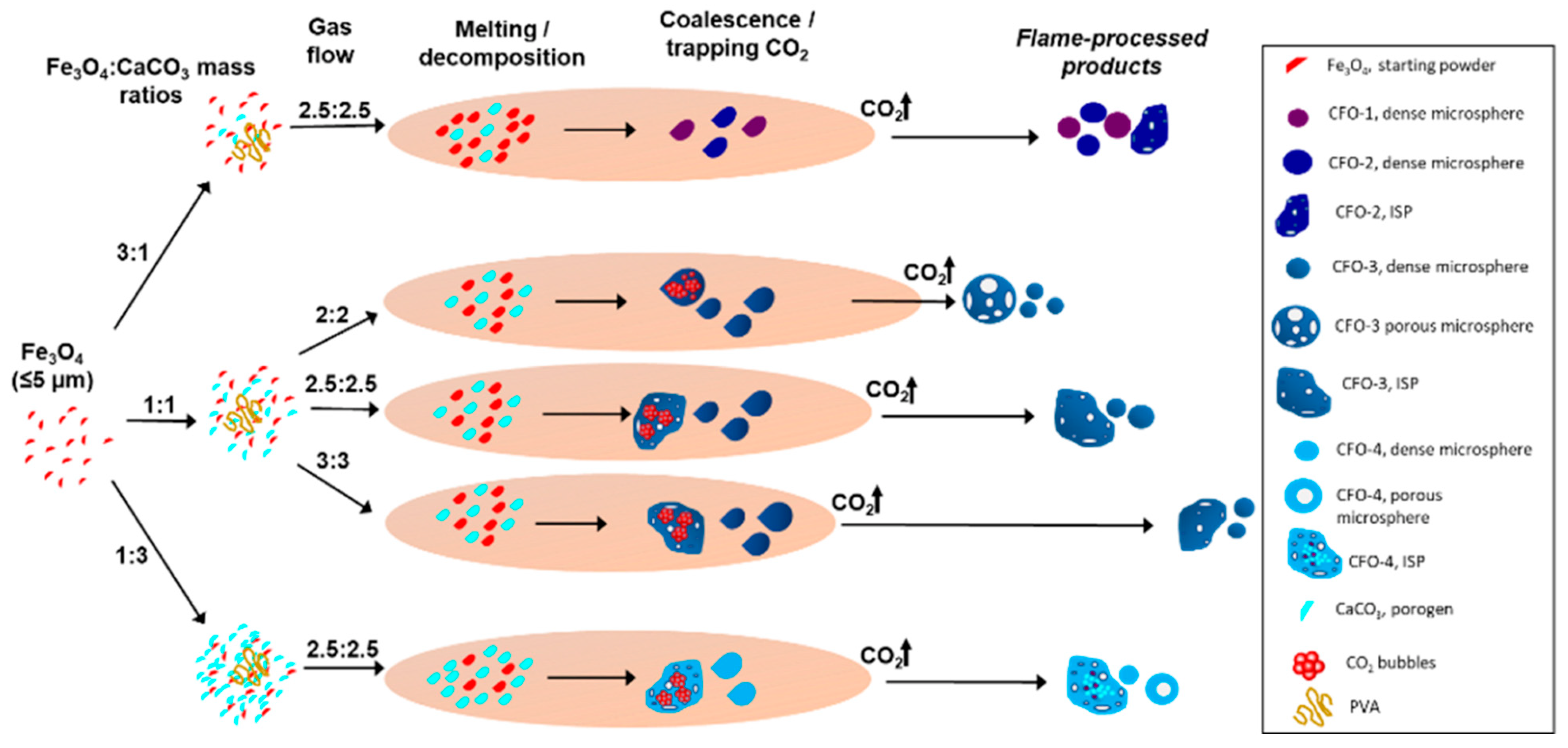

| Mass Ratio Fe3O4:CaCO3 | Gas Flow Setting/arb. Unit | Dense Microspheres/µm | ISP/ µm | Microspheres with Surface Porosity/µm |
|---|---|---|---|---|
| 3:1 | 2.5:2.5 | 35–165 | 75–475 | No |
| 1:1 | 65–210 | 205–465 | ||
| 1:3 | 40–145 | 40–195 |
| Mass Ratio Fe3O4:CaCO3 | Gas Flow Setting | Magnetic Saturation/Ms | Remanent Magnetisation/Mr | Coercive Field/ Hc | |
|---|---|---|---|---|---|
| Arb. Units | Am2/kg (emu/g) | Am2/kg (emu/g) | (kA/m) | (Oe) | |
| 3:1 | 2.5:2.5 | 36 | 3.3 | 9.1 | 115 |
| 1:1 | 10.1 | 0.6 | 7.0 | 87.5 | |
| 1:3 | 3.6 | 0.3 | 7.2 | 90 | |
| Mass Ratio Fe3O4:CaCO3 | Gas Flow Setting/arb. Units | Fe3O4/wt% | Fe3O4 with Ca/wt% | CFO-1/wt% | CFO-2/wt% | CFO-3 Ca2Fe2O5/wt% | CFO-4/wt% | CaCO3/wt% | Particles Analysed via MLA |
|---|---|---|---|---|---|---|---|---|---|
| 3:1 | 2.5:2.5 | 0.3 | 3.9 | 52.7 | 39.7 | 3.0 | 0.2 | 0.1 | 9544 |
| 1:1 | 0.1 | 0.3 | 0.1 | 1.2 | 96.5 | 1.8 | 0.0 | 4064 | |
| 1:3 | 1.0 | 0.7 | 0.7 | 1.2 | 13.9 | 64.4 | 18.1 | 23,851 |
| Mass Ratio Fe3O4:CaCO3 | Gas Flow Setting /arb. Unit | Dense Microspheres/µm | ISP/ µm | Microspheres with Surface Porosity/µm |
|---|---|---|---|---|
| 1:1 | 2:2 | 35–80 | 15–105 | 125–180 |
| 2.5:2.5 | 65–210 | 205–465 | No | |
| 3:3 | 55–150 | 175–210 | No |
| Fe3O4:CaCO3 Mass Ratio | Gas Flow Setting | Fe3O4/wt% | Fe3O4 with Ca/wt% | CFO-1/wt% | CFO-2/wt% | CFO-3/wt% | CFO-4/wt% | CaCO3/wt% | Particles Analysed via MLA |
|---|---|---|---|---|---|---|---|---|---|
| 1:1 | 2:2 | 0.0 | 0.0 | 0.0 | 0.1 | 99.6 | 0.1 | 0.1 | 1560 |
| 2.5 | 0.1 | 0.3 | 0.1 | 1.2 | 96.5 | 1.8 | 0.0 | 4064 | |
| 3:3 | 0.1 | 0.1 | 0.4 | 2.1 | 94.1 | 3.0 | 0.1 | 4127 |
| Sample | Magnetic Saturation | Remanent Magnetization | Coercive Field/Hc | |
|---|---|---|---|---|
| Am2/kg (emu/g) | Am2/kg (emu/g) | (kA/m) | (Oe) | |
| Fe3O4 dense microspheres | 96.3 | 0.8 | 0.5 | 6.7 |
| Fe3O4:CaCO3 (1:1) starting powders | 47.0 | 3.6 | 6.7 | 84.9 |
| Fe3O4:CaCO3 (1:1) microspheres | 8.9 | 0.9 | 8.7 | 109 |
| Voltage/ V | Power/ W | Current/ A | Magnetic Field/ kA/m (Oe) | Frequency/ kHz |
|---|---|---|---|---|
| 150 | 120 | 0.8 | 0.10 (1.2) | 204 |
| 35 | 20 | 0.6 | 0.07 (0.9) | 204 |
| Fe3O4 Size/µm | CaCO3 Size/µm | Mass Ratio Fe3O4:CaCO3 | Preparation | Oxygen-Acetylene Gas Flow Setting/arb. Unit |
|---|---|---|---|---|
| ≤5 | ≤5 | 3:1 | Mixed with PVA | 2.5:2.5 |
| 1:1 | ||||
| 1:3 |
| Fe3O4 Size/µm | CaCO3 Size/µm | Mass Ratio Fe3O4:CaCO3 | Preparation | Oxygen-Acetylene Gas Flow Setting/arb. Unit |
|---|---|---|---|---|
| ≤5 | ≤5 | 1:1 | Mixed with PVA | 2:2 |
| 2.5:2.5 | ||||
| 3:3 |
Disclaimer/Publisher’s Note: The statements, opinions and data contained in all publications are solely those of the individual author(s) and contributor(s) and not of MDPI and/or the editor(s). MDPI and/or the editor(s) disclaim responsibility for any injury to people or property resulting from any ideas, methods, instructions or products referred to in the content. |
© 2023 by the authors. Licensee MDPI, Basel, Switzerland. This article is an open access article distributed under the terms and conditions of the Creative Commons Attribution (CC BY) license (https://creativecommons.org/licenses/by/4.0/).
Share and Cite
Molinar-Díaz, J.; Woodliffe, J.L.; Steer, E.; Morley, N.A.; Brown, P.D.; Ahmed, I. Optimisation of the Flame Spheroidisation Process for the Rapid Manufacture of Fe3O4-Based Porous and Dense Microspheres. Molecules 2023, 28, 2523. https://doi.org/10.3390/molecules28062523
Molinar-Díaz J, Woodliffe JL, Steer E, Morley NA, Brown PD, Ahmed I. Optimisation of the Flame Spheroidisation Process for the Rapid Manufacture of Fe3O4-Based Porous and Dense Microspheres. Molecules. 2023; 28(6):2523. https://doi.org/10.3390/molecules28062523
Chicago/Turabian StyleMolinar-Díaz, Jesús, John Luke Woodliffe, Elisabeth Steer, Nicola A. Morley, Paul D. Brown, and Ifty Ahmed. 2023. "Optimisation of the Flame Spheroidisation Process for the Rapid Manufacture of Fe3O4-Based Porous and Dense Microspheres" Molecules 28, no. 6: 2523. https://doi.org/10.3390/molecules28062523
APA StyleMolinar-Díaz, J., Woodliffe, J. L., Steer, E., Morley, N. A., Brown, P. D., & Ahmed, I. (2023). Optimisation of the Flame Spheroidisation Process for the Rapid Manufacture of Fe3O4-Based Porous and Dense Microspheres. Molecules, 28(6), 2523. https://doi.org/10.3390/molecules28062523






